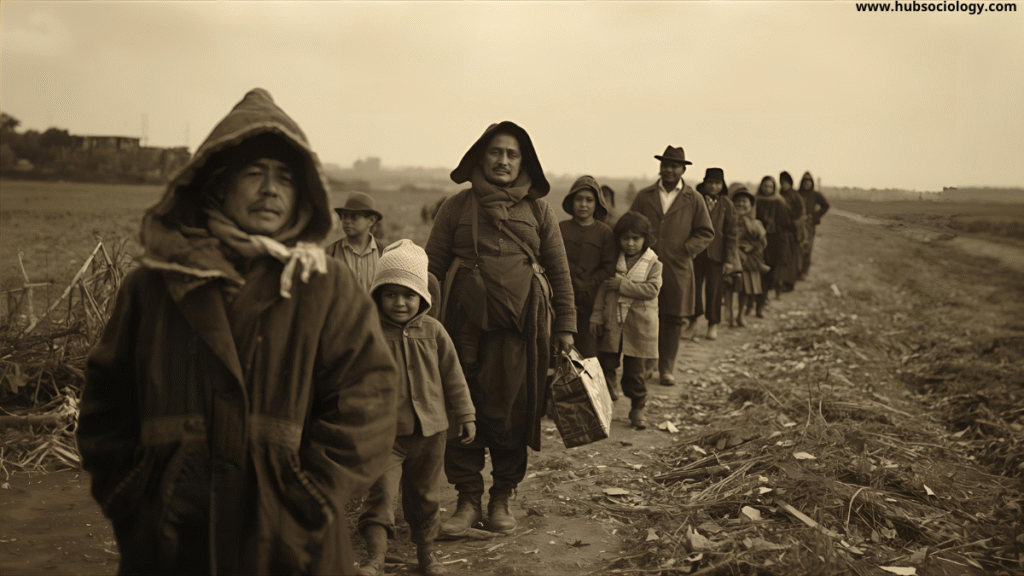Migration — the movement of people from one place to another — is one of the most significant social phenomena shaping human civilization. It involves the relocation of individuals or groups from their native place to another region, country, or continent, either temporarily or permanently. From a sociological standpoint, migration is not merely a geographical shift; it is a social process influenced by various structural, cultural, economic, and political forces that transform societies at both the origin and destination.
Meaning and Nature of Migration
Migration refers to the geographical mobility of people across defined boundaries for the purpose of residence, work, or other reasons. Sociologists view migration as a multidimensional process that affects family structures, social institutions, cultural values, and even national identities. It can be internal (within a country, such as rural-to-urban migration) or international (movement between countries).

Migration may be voluntary, where individuals seek better opportunities, or forced, caused by war, natural disasters, persecution, or economic distress. In both cases, migration reflects the dynamic relationship between individuals and the social structures that shape their choices and constraints.
Types of Migration
- Internal Migration: Movement within national boundaries — rural to urban, urban to rural, or inter-state migration.
- International Migration: Movement across national borders, either for employment, education, or asylum.
- Temporary Migration: Seasonal or short-term movement, such as agricultural laborers or construction workers.
- Permanent Migration: Movement involving a lasting change of residence.
- Voluntary Migration: Driven by personal choice and aspiration.
- Forced Migration: Involuntary displacement due to conflict, persecution, or disasters.
Determinants of Migration
Migration results from a complex interplay of push and pull factors. These determinants can be categorized into economic, social, political, demographic, and environmental dimensions.
1. Economic Factors
Economic motivation remains the most dominant cause of migration. People often migrate in search of better livelihood opportunities, higher wages, or improved living standards.
- Push Factors: Unemployment, underemployment, poverty, and lack of land in rural areas.
- Pull Factors: Industrial development, urban job opportunities, higher income, and improved infrastructure.
For instance, rural-to-urban migration in developing countries like India is primarily driven by the desire for stable income and modern amenities.
2. Social and Cultural Factors
Social mobility, education, marriage, and family networks also influence migration.
- In many societies, people migrate to join family members or relatives already settled elsewhere (chain migration).
- Cultural aspirations, such as pursuing higher education abroad or exposure to cosmopolitan lifestyles, also play a role.
- Marriage migration is common in traditional societies where women relocate to their husband’s place after marriage.
3. Political Factors
Political instability, authoritarianism, ethnic persecution, and wars often force people to leave their homelands. Refugee crises in regions like the Middle East and Africa are examples of politically motivated migration.
Conversely, democratic governance and political freedom attract migrants seeking security and dignity.
4. Demographic Factors
Population pressure, age structure, and demographic imbalances influence migration.
Overpopulation in rural areas pushes younger people toward urban centers. Conversely, aging populations in developed countries attract younger workers from abroad to fill labor shortages.
5. Environmental Factors
Environmental degradation, natural disasters, and climate change have emerged as key drivers of contemporary migration. Droughts, floods, rising sea levels, and deforestation displace millions every year.
For example, climate-induced migration is a growing challenge in South Asia and Sub-Saharan Africa.
6. Technological and Infrastructural Factors
Advancements in communication and transportation make migration easier. Improved connectivity allows migrants to maintain contact with home communities, facilitating more circular or temporary migration patterns.
Sociological Theories of Migration
Several sociological theories explain why and how migration occurs:
- Push-Pull Theory (E.G. Ravenstein):
Migration is influenced by “push” factors (hardships in origin) and “pull” factors (opportunities in destination). - Neoclassical Economic Theory:
Individuals make rational choices to maximize income differences between regions. - Dependency and World-System Theory (Immanuel Wallerstein):
Migration results from global capitalist expansion, where peripheral nations supply labor to core nations. - Network Theory:
Social networks and kinship ties facilitate migration by reducing risks and costs. - Dual Labour Market Theory:
Migration is driven by the structural demand for cheap labor in developed economies, especially for low-skilled work.
These theories collectively show that migration is not an isolated act but a deeply social process embedded within larger economic and political systems.
Consequences of Migration
Migration has profound consequences for individuals, families, and societies. Its effects can be both positive and negative, varying by context.
1. Economic Consequences
- At the Source (Origin): Migration reduces population pressure and unemployment but may lead to labor shortages in agriculture and rural industries.
- At the Destination: Migrants contribute to the labor force and economic productivity. However, excessive influx can strain infrastructure, housing, and social services.
- Remittances: Migrants send money back home, improving living standards and local economies in their home regions.
2. Social Consequences
- Cultural Exchange: Migration fosters cultural diversity and new forms of identity. Urban centers become melting pots of language, cuisine, and tradition.
- Social Mobility: Migrants often gain access to education and social networks that enhance upward mobility.
- Family Disruption: Separation from family members can cause emotional stress and weaken traditional family ties.
- Gender Dynamics: Female migration, both as workers and dependents, has altered traditional gender roles in many societies.
3. Demographic Consequences
Migration changes the demographic composition of both sending and receiving regions.
- Rural depopulation and urban overcrowding are common outcomes.
- International migration can also alter the ethnic and age structures of nations, influencing fertility rates and cultural norms.
4. Political Consequences
Migration influences national policies, citizenship debates, and identity politics.
- In host countries, immigration may lead to xenophobia or multiculturalism depending on social attitudes.
- In sending countries, governments often develop policies to engage with their diaspora communities for economic and political cooperation.
5. Environmental Consequences
Urban migration leads to rapid urbanization, environmental degradation, and strain on natural resources. Conversely, depopulated rural areas may witness land abandonment or ecological recovery.
Migration and Globalization
Globalization has intensified migration flows. The interconnectedness of markets, education, and communication enables the movement of people across continents.
Transnational migration, where individuals maintain ties with both home and host societies, is becoming increasingly common. Migrants today are not merely economic agents but also cultural ambassadors who shape global identities and hybrid cultures.

However, globalization also exposes migrants to exploitation, irregular status, and inequality. The rise of anti-immigrant politics in many Western countries shows the tension between global mobility and national sovereignty.
Migration in the Indian Context
In India, migration has been a persistent socio-economic phenomenon.
- Rural-to-urban migration dominates, driven by employment and education.
- Interstate migration from states like Bihar, Uttar Pradesh, and Odisha to Maharashtra and Delhi is common.
- International migration to Gulf countries provides remittances but often involves exploitative labor conditions.
Government policies such as the Mahatma Gandhi National Rural Employment Guarantee Act (MGNREGA) aim to reduce distress migration by providing local employment.
Conclusion
Migration is a vital component of human progress and social transformation. It reshapes economic systems, cultural landscapes, and political institutions. From a sociological perspective, migration reflects the interplay between structural inequalities and human aspirations. While it brings opportunities and diversity, it also poses challenges of integration, social justice, and identity.

In an increasingly interconnected world, managing migration requires inclusive policies that balance human rights, development, and social harmony. Understanding migration through a sociological lens helps societies appreciate its complexity — not as a problem to be solved but as a process to be guided for collective progress.
Do you like this Article ? You Can follow as on :-
Facebook – https://www.facebook.com/hubsociology
Whatsapp Channel – https://whatsapp.com/channel/0029Vb6D8vGKWEKpJpu5QP0O
Gmail – hubsociology@gmail.com
Topic Related Questions
5 Marks Questions (Short Answer Type)
- Define migration in sociological terms.
- Distinguish between internal and international migration.
- What is the difference between voluntary and forced migration?
- Mention any three major causes (determinants) of migration.
- What is the push-pull theory of migration?
- Write a short note on rural-to-urban migration.
- How does migration affect family structure?
- What is meant by chain migration?
- Explain the demographic consequences of migration in brief.
- State any two sociological theories of migration.
10 Marks Questions (Short Essay Type)
- Discuss the major determinants of migration with examples.
- Explain the economic and social consequences of migration.
- Analyze the role of globalization in influencing migration trends.
- Discuss the types of migration with suitable sociological examples.
- How do environmental factors contribute to migration?
- Examine the impact of migration on rural and urban societies in India.
- What are the major challenges faced by migrants in host societies?
- Explain the sociological relevance of network theory and world-system theory in migration.
- Discuss how gender plays a role in migration decisions and experiences.
- Analyze the relationship between migration and urbanization in developing countries.
15 Marks Questions (Long Answer / Analytical Type)
- Critically analyze the determinants and consequences of migration from a sociological perspective.
- Discuss the various sociological theories of migration and their contemporary relevance.
- Explain the socio-economic and political impacts of international migration on both sending and receiving countries.
- “Migration is both a cause and consequence of social change.” — Elaborate with sociological arguments and examples.
- Examine the role of globalization and technological advancement in shaping modern patterns of migration.
- Evaluate the positive and negative consequences of migration on family, culture, and social structure.
- Discuss the patterns and problems of migration in India in light of rural-urban and interstate migration.
- Evaluate the demographic, social, and economic impacts of migration on both sending and receiving areas.
- Examine the sociological implications of forced migration and refugee crises in the contemporary world.
- Discuss how migration acts as an agent of social mobility and cultural transformation.
